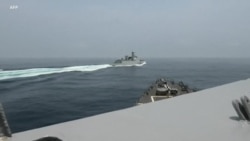South Korea scrambled its fighter jets after Chinese and Russian military aircraft entered its air defense identification zone (ADIZ) in the south and east of the Korean Peninsula on Tuesday — an incident that followed two recent encounters between American and Chinese forces in the Taiwan Strait and South China Sea.
China's Defense Ministry said in a statement that the aircraft that entered Seoul's ADIZ were participating in an annual joint air exercise with Russia over the Sea of Japan and the East China Sea — the sixth such drill since 2019. The latest drills were launched on the heels of U.S. joint military exercises with Seoul.
South Korea's ADIZ is not part of the country's airspace; however, neither country gave notice that its planes were entering the zone, according to South Korea's Yonhap news agency.
Tuesday's incursion followed two earlier close encounters: A Chinese warship crossed closely in front of a U.S. destroyer in the Taiwan Strait on Sunday, and a Chinese fighter jet maneuvered near an American military plane in international airspace over the South China Sea on May 26. A Biden administration official has cited the incidents as examples of Beijing's increasing "aggressiveness."
The encounters with Chinese vessels coincide with trilateral naval exercises between the coast guards of U.S., Japan and the Philippines in the South China Sea.
Such incidents increase the risk of miscalculations and escalation as tensions rise between Washington and Beijing over issues ranging from trade policies to Russia's invasion of Ukraine and Taiwan's security.
New and disturbing norms
Beijing incursions in the region have been steadily ramping up in recent years. Just in 2023, there have been at least 745 incursions by Chinese military aircraft into Taiwan's ADIZ alone, according to data from Taiwan's Ministry of National Defense.
Meanwhile, Washington is projecting a more muscular presence in the Indo-Pacific, increasing its military drills and shoring up extended deterrence with allies including South Korea, Japan and the Philippines.
Wang Wenbin, spokesperson for the Chinese Ministry of Foreign Affairs, said during his news briefing Tuesday that the encounters are not about freedom of navigation, as the United States contends, but "hegemony of navigation and distinct military provocation."
"The U.S. has been sending warships and military aircraft halfway around the world to China's doorsteps and engaging in close-in reconnaissance and showoff of military muscle near China's territorial sea and airspace," Wang said.
Encounters in the Indo-Pacific between the two rivals have become the "new and disturbing norm," said Zuri Linetsky, a research fellow at the Eurasia Group Foundation.
"Both parties, the United States and China, are acting poorly and kind of instigating and spiraling the tensions," Linetsky told VOA. "That has knock-on effects for regional players — in this case South Korea — but also Japan and Taiwan."
John Kirby, National Security Council coordinator for strategic communications, rejected the notion that the U.S. is partly to blame for the escalation.
"We all want to see the tensions come down," he told VOA during the White House news briefing Tuesday, arguing that the administration is working "very, very hard," to de-escalate, but their diplomatic outreach has so far been unreciprocated by Beijing.
Last week, Beijing declined Washington's request for a face-to-face meeting at the annual Shangri-la Dialogue in Singapore between Defense Secretary Lloyd Austin and his Chinese counterpart Li Shangfu, due to personal sanctions on Li that have not been lifted by the administration.
However, there has been some progress on the diplomatic front, with high-level officials from the U.S. State Department and the National Security Council holding private talks with their Chinese counterparts in recent weeks.
Officials are also working to reschedule U.S. Secretary of State Antony Blinken's visit to Beijing that Washington canceled after it shot down a Chinese spy balloon in February.
Increased defense spending
Growing concerns over China, whose military expenditure has increased for 28 consecutive years, have helped fuel an arms race in the region.
According to military spending data from the Stockholm International Peace Research Institute (SIPRI) in 2022, countries in Asia and Oceania spent $575 billion in defense, a 2.7% increase from 2021 and a 45% increase from 2013, continuing an uninterrupted upward trend dating back to at least 1989.
Global military expenditure increased by 3.7% in 2022, according to SIPRI data, mainly driven by a heightened threat from Russia's invasion of Ukraine and tensions in East Asia.
"The continuous rise in global military expenditure in recent years is a sign that we are living in an increasingly insecure world," said Nan Tian, a senior researcher with SIPRI's Military Expenditure and Arms Production Program. "States are bolstering military strength in response to a deteriorating security environment, which they do not foresee improving in the near future."
Jorge Agobian contributed to this report.













